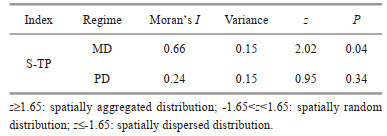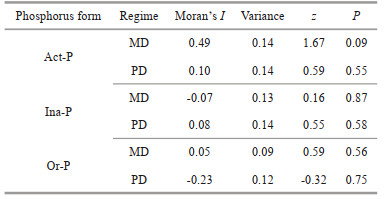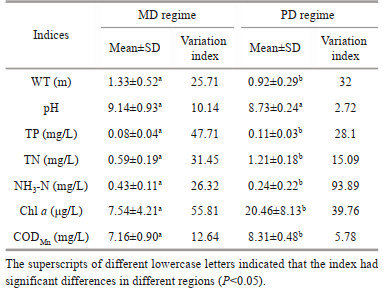Institute of Oceanology, Chinese Academy of Sciences
Article Information
- DONG Jixing, GUO Yanmin, XIA Pinhua, TIAN Yuanbin, ZHENG Feifei, LI Anyan, LIN Tao, LI Ruiwen
- Lake regime shift from submerged macrophyte to phytoplankton affected phosphorus speciation in sediment and eutrophic state in Caohai Lake, Guizhou, China
- Journal of Oceanology and Limnology, 41(6): 2262-2275
- http://dx.doi.org/10.1007/s00343-022-2261-4
Article History
- Received Jul. 4, 2022
- accepted in principle Aug. 22, 2022
- accepted for publication Sep. 30, 2022
2 Yangtze River Basin Ecological Environment Monitoring and Scientific Research Center, Yangtze River Basin Ecological Environment Supervision and Administration Bureau, Ministry of Ecological Environment, Wuhan 430010, China
Lakes, especially shallow lakes, its water state can change from submerged-macrophyte-dominance (clear water) under long-term nutrient input to phytoplankton-dominance (turbid water) under short-term disturbances (Scheffer and van Nes, 2007; Yu et al., 2020; Su et al., 2021; Yuan et al., 2021). This regime shift in lake ecosystem can result in damage to water function, degradation of aquatic ecology, and algal blooms (Zong et al., 2019; Luo et al., 2020). In addition, phosphorus exchange can change during regime shifts in a lake, and phosphorus in the sediments can change the exchange flux of phosphorus to the water through release and resuspension processes. This process can develop in the direction conducive to the growth of phytoplankton. Therefore, the phosphorus exchange characteristics of the sediment-water interface are the key to controlling the phosphorus concentration of lake water (Vadeboncoeur et al., 2001; Liu et al., 2020). Phosphorus is usually a limiting factor for primary productivity in lakes (Wu et al., 2014; Chen et al., 2018), and changes in phosphorus during regime shift in a lake have an important influence on the lake ecosystem.
Phosphorus in the sediments exists in the form of inorganic phosphorus and organic phosphorus. Organic phosphorus (Or-P) is mainly the phosphorus contained in various animal and plant residues and humus organic matter in sediments. It can only be release after mineralization of organic matter, which is relatively difficult to be directly used by organisms. Inorganic phosphorus can be divided into exchangeable phosphorus (Ex-P), aluminum-binding phosphorus (Al-P), and Fe-binding phosphorus (Fe-P) according to the extracted forms. Occluded phosphorus (Oc-P), authigenic calcium phosphorus (Aca-P), detrital calcium phosphorus (De-P) (Reitzel et al., 2007; Jiang et al., 2011). Exchangeable phosphorus is phosphorus attached to the surface of carbonate or clay particles, wind-wave disturbances can lead to the release of exchangeable phosphorus. Metal-binding phosphorus (Al/Fe-P) is bound and adsorbed by metal oxides or metal hydroxides as substrates, which is significantly affected by redox conditions at the sediment-water interface. Zhu et al. (2004) referred to the three forms of exchangeable phosphorus, aluminum-binding phosphorus, and Fe-binding phosphorus that are relatively easy to release and used by organisms as active phosphorus (Act-P) (Zhu et al., 2004). The occluded phosphorus is mainly phosphorus tightly wrapped in mineral particles such as Fe and Al. Detrital calcium phosphate is a part of phosphorus in primary mineral particles in sediments. Authigenic calcium phosphorus is the biological deposition and consolidation of granular phosphorus in sediments. All three are difficult to be bioavailable and are called inactive phosphorus (Ina-P) in inorganic phosphorus.
The form of phosphorus in sediments is closely related to the biogeochemical characteristics of phosphorus. Different forms of phosphorus have different effects on the phosphorus concentration of the water (Barik et al., 2016; Wang and Liang, 2016; Cheng et al., 2018; Jiao et al., 2018). Active phosphorus (Act-P) is the most important form affecting the eutrophication of a water body because it is easily released from sediments and enters the water recycling process (Jiang et al., 2011). Organic active phosphorus (Or-P) is a type of potential bioavailable phosphorus, and can be converted into bioavailable phosphorus through degradation and hydrolysis, which may pose a risk of eutrophication in a water body (Zhang et al., 2017). Relatively complicated release conditions of inactive phosphorus (Ina-P) in sediment, and it would pose a small threat to eutrophication, but also would affect water transparency due to resuspension of suspended matter (Su et al., 2016). Although many studies have been carried out on the various forms of phosphorus in lake sediments, most focused on the spatial distributions of various phosphorus species (Dehbi et al., 2019; Li et al., 2019a; Chen et al., 2020; Zhao et al., 2020), hydrophytes (Dai et al., 2015; Li et al., 2021), hydrographic conditions (Ni et al., 2015; Yu et al., 2019; Zhao et al., 2022), phytoplankton (Hao et al., 2016; Chao et al., 2017), and the relationship among different phosphorus forms in sediment. Few have been conducted on the changes in phosphorus specification in sediment and its effects on water quality of a shallow lake ecosystem during the shift from a submerged macrophyte dominance to a phytoplankton dominance.
In recent years, a large area of submerged macrophytes in Caohai Lake has died out and, with obvious turbid water bodies and serious water eutrophication, the aquatic ecosystem has been degraded. At present, the ecosystem is in a critical transition stage from a regime of clear water to a regime of turbid water (Wu et al., 2022). To reveal the changes in form of phosphorus in sediment and its impact on water quality during regime shift, and to provide a reference for lake protection and restoration, Caohai Lake in Guizhou Province was studied. Sediment and water samples were collected in July 2020 (before regime shift when the submerged macrophyte died out locally) and July 2021 (after regime shift when submerged macrophyte died out in large areas). Changes in the form of phosphorus in surface sediments and the impact on water quality were analyzed.
2 MATERIAL AND METHOD 2.1 Study areaCaohai Lake (26°47′35″N–26°52′10″N, 104°9′23″E–104°20′10″E, altitude 2 170 m) is located in Weining County, Guizhou Province. It is the largest natural shallow freshwater lake in Guizhou Province and the largest natural karst wetland in China. The protected area is 120 km2, and the average depth of the lake is about 2 m. In 1992, the area around Caohai Lake was protected as a natural reserve. The lake area is characterized by plateau subtropical climate; and on yearly average, temperature is 10.6 ℃ and rainfall 980 mm. Caohai Lake is rich in biodiversity, and is an important wintering place for water birds, such as black-necked crane (Grus nigricollis). The fish population increased from eight species in 1985 to 18 species in 2016, including Carassius auratus, Pseudorasbora elongata, Hypseleotris swinhonis (Gunther), and Pseudoperilampus lighti. The lake contained 37 species of aquatic vascular plants, and the common submerged plants were Potamogeton lucens L., Najas marina, Myri Org-Phyllum aquaticum, and Cerat Org-Phyllum demersum L. They grew vigorously in this lake.
The government attaches great importance to the protection and treatment of the Caohai Lake, and the external pollution has been controlled. However, due to the ecological imbalance in the lake, submerged macrophytes had disappeared in a large area, and the regime has changed from clear water dominated by submerged macrophytes to turbid water dominated by phytoplankton (Wu et al., 2022). The reason for the regime shift may be resulted from water level rise and the decrease in fluctuation amplitude. The composition and quantity of fish community increased greatly, and this leads to more fragile aquatic ecosystems.
2.2 Sample collection and processingAccording to the distribution of the lake area, nine sampling points (S1–S9) were selected in Caohai Lake area using a handheld global positioning system (GPS) instrument (Fig. 1). The sites were chosen to reflect the overall sediment status of the lake. The samples were collected before the regime shift in July 2020 (macrophyte-dominance, MD) and after the regime shift in July 2021 (phytoplankton-dominance, PD). A polyethylene sampler was used to collect the upper water samples, and a handheld cylindrical mud sampler was used to collect the surface sediment samples in upper 2–5 cm of sediments, which were then placed in sample bags (the contaminated surface soil of the sediment layer was removed, and only the central part was analyzed). All of the collected samples were homogenized and placed in special sampling bags, which were immediately stored at a low temperature and transported back to the laboratory for further treatment.
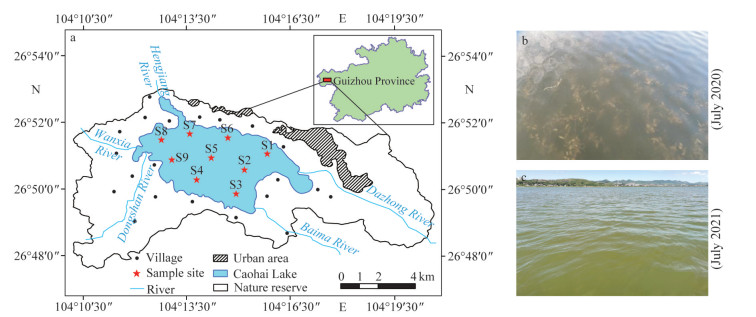
|
| Fig.1 Distribution of sampling sites a. distribution of sampling sites; b. before the shift of lake regime; c. during the shift of lake regime. |
Based on the basic physical and chemical characteristics of Caohai sediments, a seven-step continuous chemical extraction method with clear classification and a good extraction effect was adopted, and the improved the Standards, Measurements and Testing Programme (SMT) (Ruban et al., 1999) sediment phosphorus extraction method of Zhu et al. (2004) was used. Using the method, phosphorus in sediment was divided into Ex-P, Al-P, Fe-P, Oc-P, Aca-P, De-P, and Or-P. The moisture content (MC) and loss on ignition (LOI) values of the sediments were determined using the soil agrochemical analysis method (Bao, 2000). The pH of sediment (S-pH) was determined by the mass ratio of water to soil 10꞉1 potentiometric method. The total phosphorus in the sediment (S-TP) was determined using the acid soluble-molybdenum antimony colorimetric method. The Kjeldahl digestion method was used to determine the total nitrogen in sediment (S-TN), and the organic carbon in the sediment (S-SOC) was determined using the potassium dichromate volumetric method and the external heating method. Dissolved oxygen and pH were measured using a portable instrument (HQ30D, Hach, Loveland, CO, USA). The physicochemical properties of the overlying water were measured according to the standard Chinese method for surface water (GB3838-2002, 2002). Water transparency (WT) was measured using a Secchi disc. Total nitrogen (TN) was measured in alkaline persulfate digestion and ultraviolet spectrophotometry (UV mini-1240, Shimadzu, Japan). The total phosphorus (TP) content was spectrophotometrically determined. Ammonia nitrogen (NH3-N) was spectrophotometrically determined using a nano reagent, chemical oxygen demand (CODMn) was determined using the potassium permanganate index method, and chlorophyll a (Chl a) was spectrophotometrically determined after extraction with 90% ethanol (State Environmental Protection Administration, 2002).
2.3 Statistical analysisThe experimental data were sorted using Microsoft Excel 2016, those that did not follow normal distribution were logarithmically transformed. Pearson correlation analysis was performed using the R 4.0.4 software, and the Canoco 5.0 software was used to conduct the principal component analysis of the environmental factors. The SPSS 25.0 software was used to conduct single factor analysis of variance and stepwise linear regression analysis. The spatial distributions of phosphorus forms in sediment and the physico-chemical indexes of water body were analyzed using the spatial interpolation method and ArcGIS 10.6. The spatial autocorrelation Moran's I index was calculated for the different forms of phosphorus as attributes to analyze the spatial aggregation of the total phosphorus and the different forms of phosphorus.
The integrated sediment pollution index was evaluated (Leivuori and Niemistö, 1995). The comprehensive pollution index was calculated using Eqs.1 & 2 for the single pollution index.
 (1)
(1)where Si is the single evaluation index or the standard index, and Ci is the measured value of evaluation factor i. Cs is the standard value of evaluation factor i. The Cs of the soluble organic matter (SOM) in the sediment was 17.24 g/kg (SOM in sediment was obtained via conversion of the total organic carbon in the sediments (S-TOC)); the Cs of the S-TN was 0.55 g/kg; and the Cs of the S-TP was 0.60 g/kg.
 (2)
(2)where F is the average value of the n pollution indexes (S-TN and STP), and Fmax is the largest single pollution index (STN and STP). FF < 1.0, clean; 1.0≤FF≤1.5, mild pollution; 1.5 < FF≤2.0, moderate pollution; FF > 2.0, severe pollution.
The trophic level index (Xu et al., 2012) was calculated as Eq.3:
 (3)
(3)where TLI (j) is the nutritional status index of parameter j, and Wj is the relevant weight of the nutritional status index of parameter j.
The nutrient status was defined as follows: nutrient depleted (TLI(Σ) < 30); moderate nutrient status (30≤TLI(Σ)≤50); mildly eutrophic (50 < TLI (Σ)≤60); moderately eutrophic (60 < TLI(Σ)≤70); and severely eutrophic (TLI(Σ) > 70).
The multiple linear regression equation and stepwise regression equation model are as Eq.4:
 (4)
(4)where Y is the dependent variable, xi (i=1, …, p) is the independent variable p, b0 is the constant term in the regression equation, and bi (i=1, …, p) is the regression coefficient.
3 RESULT 3.1 Temporal and spatial distribution characteristics of the TP in the sedimentsThe S-pH of MD (macrophyte-dominance) surface sediments ranged from 7.90 to 8.51, on average of 8.12, while that of PD (phytoplankton-dominance) was 7.23–7.98 on average of 7.59, which is weakly alkaline. The S-pH was significantly different between the two different regimes (P < 0.01). The spatial distribution of the S-TP in Caohai Lake is shown in Fig. 2. After the regime shift from MD to PD, the average S-TP decreased from 0.87 to 0.70 g/kg, with a significant difference (P < 0.05). The S-TP content ranged from 0.71–1.08 to 0.48–0.84 g/kg. Before the regime shift, the S-TP content was significantly higher in the eastern part of the lake than in the other parts, and the spatial heterogeneity was significant, exhibiting an aggregated distribution (z=2.02, P= 0.04) (Table 1). After the regime shift, the S-TP content decreased southwestward, but the spatial heterogeneity was not significant (z=0.95).

|
| Fig.2 Spatial distribution of S-TP content in Caohai Lake *: significant correlation (P < 0.05). |
The S-TP pollution in Caohai Lake was evaluated using the single-factor index method. The lowest level of ecological risk regarding the TP concentration (600 mg/kg) released from sediment defined by the Ministry of Environment and Energy of Ontario, Canada (1992) was used as the reference standard (Leivuori and Niemistö, 1995). Results show that the S-TP pollution index decreased from 1.46 to 1.16 before regime shift; however, there is still a degree of ecological risk. The comprehensive pollution index values (FF values) of the sediments of MD and PD were 6.84 and 5.51, indicative of Grade 4, it indicated that the nitrogen and phosphorus pollution in the Caohai Lake was serious.
3.2 Temporal and spatial heterogeneity of phosphorus forms in sedimentThe content and proportional distribution of the forms of phosphorus in Caohai Lake sediments are shown in Fig. 3. The proportions of different forms of phosphorus in the S-TP in the two different regimes were in the order of: Or-P > De-P > Oc-P > Aca-P > Fe-P > Al-P > Ex-P. Or-P was the main component. In the MD and PD regimes, Act-P (Ex-P, Al-P, and Fe-P) was accounted for 5.35% and 4.69% of S-TP, respectively. The average Ex-P, Al-P, and Fe-P contents decreased from 3.18±0.62, 7.85±2.19, and 14.93±7.39 mg/kg before regime shift to 1.98±0.97, 5.10±1.65, and 10.39±7.40 mg/kg after regime shift, respectively. Ex-P, Al-P, and Fe-P decreased from 0.67%, 1.63%, and 3.06% to 0.53%, 1.39%, and 2.77%, respectively. The Ex-P content was significantly different in the two different regimes (P < 0.01), and so was the Al-P and Fe-P contents (P < 0.05) (Fig. 3). The spatial distribution of Act-P is shown in Fig. 4. Before regime shift, the Act-P content was higher in the northeastern part of the lake near urban area, and it decreased from northeast to southwest. Act-P was spatially distributed in aggregation (z=1.67, P= 0.09). After regime shift, the areas with low Act-P contents were located in a deepwater area near the northwestern edge of the lake and the outlet of the lake, but the spatial distribution of Act-P contents showed no significant difference (z=0.59, P=0.55).
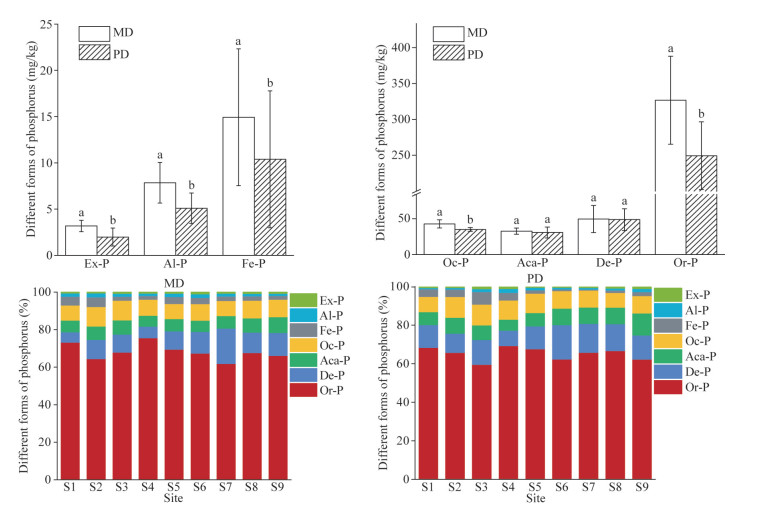
|
| Fig.3 Phosphorus speciation and proportional distribution in sediments of Caohai Lake in the MD and PD regimes Different lowercase letters indicate significant differences between the two regimes (P < 0.05). |
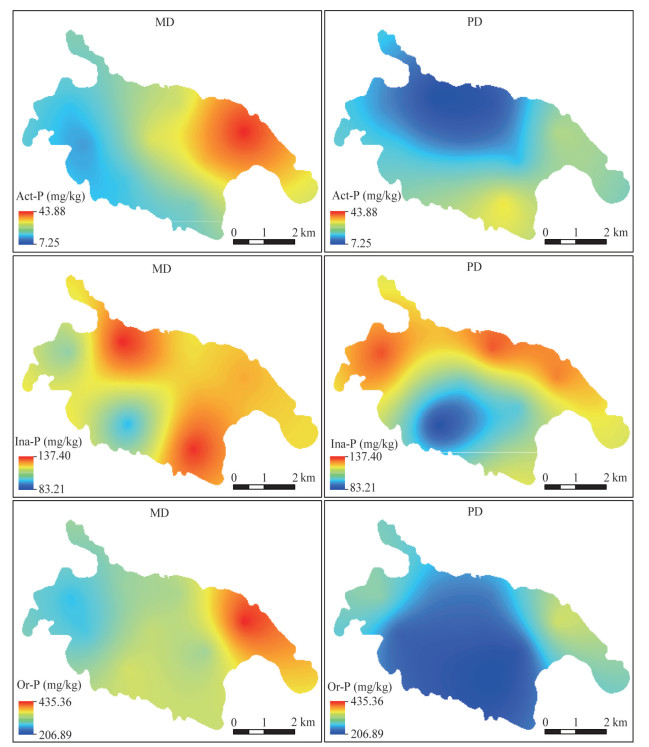
|
| Fig.4 Spatial distribution of each phosphorus form in sediments in the MD and PD regimes |
Regarding the Ina-P (De-P, Oc-P, and Aca-P), the average Ina-P content decreased from 124.93± 13.25 mg/kg before regime shift to 114.50±12.33 mg/kg after; however, the difference was not significant (P > 0.05). The proportion increased from 26.42% to 29.99% before the steady-state conversion, and it increased by 3.57% after regime shift (Fig. 3). Before regime shift, Ina-P content was higher at the Baima River inlet in the southwestern corner and the Baima River outlet in the northeastern corner. After regime shift, Ina-P was lower in the shallower area near Dongshan Village (Fig. 4).
The mean Or-P content decreased from 326.71± 61.23 mg/kg before regime shift to 249.48±47.13 mg/kg after, showing a highly significant difference (P < 0.01), and the proportion decreased from 68.23% to 65.32% (Fig. 3). There was small spatially heterogeneity (-1.65 < z < 1.65) in the Or-P between two regimes (Table 2), with higher contents in the northeast in both regimes. The Or-P content was higher in the shallow western region than in the deep central region after the regime shift (Fig. 4).
The pH range decreased from 8.76–9.61 before regime shift to 8.70–8.76 after, exhibiting weak alkalinity. The water temperature was 18–21 ℃ during the sampling period. The concentrations of TN, TP, NH3-N, CODMn, and Chl a were significantly different in the two regimes (P < 0.05). Except for NH3-N, the values of these chemical indicators were increased after the regime shift, and the variation coefficient of NH3-N was the greatest (Table 3). The TN and TP contents of the water increased from 0.59±0.19 and 0.08±0.04 mg/L before regime shift to 1.21±0.18 and 0.11±0.03 mg/L after regime shift, respectively. The TN/TP ratio increased from 7.13 to 10.61, and the shift from a nitrogen to an algae growth restriction factor before regime shift was beneficial to the growth of algae. The Chl-a content was increased 2.7 times after regime shift (Table 3). The principal component analysis (PCA) of the physical and chemical properties of the water during the different regimes in Caohai Lake explained 93.49% of the total variations, that is, it explained the overall changes well. The distribution of the same type was relatively concentrated, and the heterogeneity of the distribution was obvious before and after regime shift. The main physical and chemical index affecting the different regime partitions was the TN (Fig. 5). The average TLI value increased from 48.42 to 54.49 before regime shift (P < 0.01), and the mesotrophic lake became a mildly eutrophic lake. The result of the kriging interpolation analysis of the TLI value is shown in Fig. 6. Before the regime shift, the TLI value was lower in the western and southwestern parts of the lake, the lower values were in the southwestern corner of the lake, and the higher values were in the eastern part of the lake. After the regime shift, there was a decreasing trend from upstream to downstream, and most of the areas exhibited mild eutrophication.
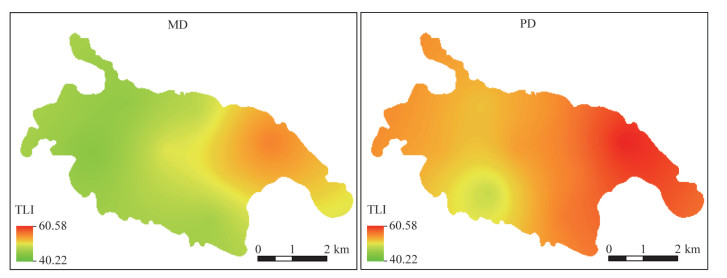
|
| Fig.5 Spatial distribution of the TLI content in Caohai Lake |
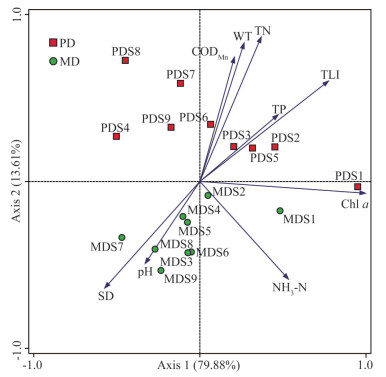
|
| Fig.6 Principal component analysis of the physical and chemical indexes of Caohai Lake water |
The analysis results of the relationships between the physico-chemical indexes of water and the forms of phosphorus in sediment in different regimes are shown in Fig. 7. Before regime shift, Act-P was significantly correlated with WT, pH, and Chl a (P < 0.05), and it was extremely and significantly correlated with TP and TLI (P < 0.01) (Fig. 7). After regime shift, Act-P exhibited a very significant positive correlation with TP (P < 0.001), and Ina-P exhibited a very significant negative correlation with water transparency (P < 0.001). After regime shift, Or-P was significantly correlated with TN in the water (P < 0.01) and was negatively correlated with WT (P < 0.05) (Fig. 7). Multiple linear regression analysis can also more accurately describe the influence of the forms of phosphorus on TP content of the water. Stepwise regression analysis revealed that Fe-P was the main factor affecting TP in different regimes, and it explained 50.9% and 88.7% of TP variance before and after regime shift, respectively (Table 4).

|
| Fig.7 Correlation analysis of the forms of phosphorus in the surface sediments of Caohai Lake and the physical and chemical indicators of the water *: P < 0.05; **: P < 0.01; ***: P < 0.001. |

|
Relationships between sediment properties and phosphorus forms in sediment under different regimes are shown in Table 5. After regime shift, correlation of Act-P to S-TP and S-pH decreased, and that to S-SOM and MC increased (P < 0.05). After steady-state conversion, correlation between Ina-P and S-TP increased, showing a significant positive correlation to each other (P < 0.05), and correlation between Or-P and S-SOM decreased (P > 0.05) (Table 5).

|
The average phosphorus content of Caohai Lake sediments was lower than that of the Erhai Lake (Liu et al., 2015; Zhao et al., 2020), Dianchi Lake (Yang et al., 2018), Taihu Lake (Wu et al., 2019), Chaohu Lake (Jiao et al., 2018), and Poyang Lake (Pu et al., 2020). It indicated that the internal phosphorus load in Caohai Lake is relatively low. The proportions of different forms of phosphorus in S-TP in different regimes in Caohai Lake were as follows: Or-P > Ina-P > Act-P, which is consistent with the results of Yu et al. (2022), and Or-P was the main component. In contrast, in other lakes at the same latitude, such as Wuhan Donghu (East) Lake (Zhang et al., 2016b), Taihu Lake (Li et al., 2019b), and Chaohu Lake (Yang et al., 2020), the proportions of phosphorus forms in sediment were in the order of Act-P > Ina-P > Or-P. The reason for the difference may be that Caohai Lake is a typical submerged plant lake with high submerged plant biomass (Shi et al., 2022), and a large amount of aquatic plant residue accumulates annually. In addition, Caohai Lake is located in the Yunnan-Guizhou Plateau in annual average temperature of 10.6 ℃. The temperature is low, and thus the decomposition of the submerged plant residue is slow. Therefore, the input of submerged plant residue led to a high Or-P content in Caohai Lake sediments.
The FF value of S-TP in surface sediment decreased from 1.46 before regime shift to 1.16 after regime shift. FF values of greater than 1 indicates that the phosphorus pollution in Caohai Lake sediments was serious, and the ecological risk posed by phosphorous release was high. The redox potential, pH, and biomass of submerged macrophytes and phytoplankton, they all affect the rate of phosphorus release from sediments (Xie et al., 2003; Phillips et al., 2016). Some scholars have found that the release rate of phosphorus from lake sediments without submerged macrophytes was significantly higher than that of lake sediments with submerged macrophytes (Zhang et al., 2016a). In this study, we found that the average S-TP content of the non-sediment plants was lower after regime shift than before regime shift (P < 0.05). The reason for this is that after the regime shift, a large number of submerged plants were reduced, and the phosphorus was lost due to water flow during the wilting of plants, which reduced the input of Or-P to the sediments. Secondly, a large number of aquatic plants die out, losing the fixation of sediments and promoting sediment resuspension and release.
Act-P includes Ex-P, Al-P, and Fe-P. Act-P is very sensitive to environmental factors such as pH, temperature, oxidation-reduction potential, and hydrodynamics (Statham et al., 2012). A decrease in the amount of submerged plants can reduce the redox potential and pH of the surface layer of sediments, and the phosphorous is easily released into the adjacent water under a mild disturbance or elevated temperature (Duras and Hejzlar, 2001; Genkai-Kato and Carpenter, 2005; Genkai-Kato, 2007; Jensen et al., 2017). This study showed that the Act-P content of the sediments after the steady-state conversion decreased significantly (P < 0.01), and the proportion decreased from 5.35% to 4.69%, S-pH was significantly different in the two different regimes (P < 0.01), indicating that the regime shift in Caohai Lake promoted the release of the Act-P in surface sediments which is consistent with Tammeorg et al. (2022) in Võrtsjärv of a large shallow lake in Estonia.
Ina-P is mainly a stable type of phosphorus formed by input from terrigenous sources such as authigenic apatite and clastic rocks. It is less likely to be released from sediments into water and is not affected by human activities (Adachi et al., 2003; Tammeorg et al., 2022). The sediment mineralization processes are consistent with the ecosystem's stability without external disturbance (Zhu et al., 2013). We also found that the average Ina-P content did not decrease significantly due to the regime shifts (P > 0.05), after regime shift, Ina-P was not significantly correlated with other properties of sediments except for S-TP (P > 0.05), the proportion of Ina-P in the total phosphorus after regime shift increased by 3.57% from that before regime shift. The reason for this is that the Act-P and Or-P decreased significantly after regime shift, which led to an increase in the proportion of total phosphorus after regime shift. It shows that the regime shift in Caohai Lake had no significant effect on Ina-P.
The Or-P in sediment comes mainly from the accumulation of aquatic animal and plant residues, and some of the unstable phosphorus is easily decomposed into Act-P through mineralization, which has a potential release risk (Vaalgamaa, 2004; Ahlgren et al., 2006; Wan et al., 2020). The proportion of Or-P decreased from 68.23% before regime shift to 65.32% after it, accounting for a large proportion of the total phosphorus. Compared with other lakes in the Yunnan-Guizhou Plateau and the middle and lower reaches of the Changjiang River, the risk of the direct release of total phosphorus in Caohai Lake was smaller. However, due to the high proportion of Or-P, it posed a large potential risk of phosphorus release. The large proportion of Or-P in Caohai Lake in the Yunnan-Guizhou Plateau was mainly due to the accumulation of a large amount of aquatic plant residue each year. The low temperature in winter and the slow decomposition of submerged plant residue led to the high content of Or-P in the sediments in Caohai Lake, which is consistent with the results of Yu et al. (2022).
4.2 Effect of sediment phosphorus forms on water before and after regime shiftAct-P plays an important role in water eutrophication. Some researchers believe that sediment resuspension is an important way for phosphorus desorption into water to participate in the cycle (Kristensen et al., 1992; Cyr et al., 2009). This potential endogenous phosphorus load is a key factor affecting the TP content in the water (Bastami et al., 2021; Lu et al., 2021). Small changes in environment could cause the release of phosphorous from sediments into water (Zhuang et al., 2014). We found that the Act-P was significantly correlated with the TP content of water before regime shift (P < 0.01), and more significantly correlated after regime shift (P < 0.001). Results of stepwise regression analysis show that among the seven forms of phosphorus, Fe-P was the main factor affecting the TP content in water, which explains why the TP variance increased from 50.9% before regime shift to 88.7% after the shift. The Fe-P had a higher contribution for the TP content of water after regime shift, indicating that during the recession of submerged plants, although the proportion of Fe-P in the total phosphorus in sediment decreased after regime shift, it contributed more to the TP content of the water, which is agree with Jensen et al. (2017) for Xihu (West) Lake, Huizhou, Guangdong, South China.
The resuspension of sediments, and the migration and diffusion of substances (Horppila and Nurminen, 2003; Li et al., 2008; Søndergaard et al., 2010; Jäger and Diehl, 2014) into the water affected the transparency of water. We found that the spatial distribution of Ina-P was similar to that of the water transparency, and it was significantly and negatively correlated with water transparency in the water (P < 0.001). The reason for this is that Ina-P may have been partially affected by the velocity of the water flow (Madsen and Cedergreen, 2002) and the turbulence intensity (Wang et al., 2016) during the recession of submerged plants in Caohai Lake.
Microbial degradation and mineralization of Or-P play a vital role in migration and transformation of phosphorus, and may turn Or-P into inorganic phosphorus in the water to participate in the geochemical cycle (Wan et al., 2020). A large amount of organic matter could promote the microbial activity, which could strengthen the nitrification and denitrification and accelerate the transformation rate of the transformable nitrogen in the sediments (Schauser et al., 2006). We found that the Or-P was extremely significantly positive correlated with TN after regime shift (P < 0.01), which is consistent with Klamt et al. (2019) on eutrophic lakes (Lake Gollinsee, Germany) due to the increases in the primary productivity and the organic matter content, as well as the increases in organic matter content and water content of the sediments (Hemond and Lin, 2010; Su et al., 2021).
5 CONCLUSIONTaking Caohai Plateau Lake in Guizhou Province as an example, the effects of regime shift from submerged macrophyte dominance to phytoplankton dominance on the speciation and distribution of the phosphorus in the sediments were studied, and the following conclusions weremade.
(1) The average phosphorus content in sediment in Caohai Lake was lower than those of Erhai Lake and Dianchi Lake in the Yunnan-Guizhou Plateau, and was also lower than those of Taihu Lake, Chaohu Lake, and Poyang Lake in the middle and lower reaches of the Changjiang River Plain. In addition, the phosphorus content of sediments was significantly different from those of the lakes in the middle and lower reaches of the Changjiang River. The main occurrence form of phosphorus in the sediments of Caohai Lake was Or-P, followed by Ina-P and Act-P. The low content of Or-P in Caohai Lake may be due to the abundance of aquatic plants before regime shift.
(2) The regime shift decreased the content and proportion of the total phosphorus, Or-P, and Act-P, but it did not significantly affect the Ina-P. The decrease in the total phosphorus and Act-P contents of the sediments may have been related to the increase in the phosphorus released due to the regime shift, and the decrease in the total phosphorus was also related to the decrease in the input of Or-P.
(3) The regime shift increased the eutrophication, and the TLI increased from 48.42 to 54.49 (P < 0.01). The eutrophic state of Caohai Lake changed from a mesotrophic lake to a mildly eutrophic lake. The TP content of water increased from 0.08±0.04 to 0.11± 0.03 mg/L, and the Fe-P contributed greatly to the TP content of the water.
(4) Although the sediment form of phosphorus and water column physicochemical before and after the shift of the Caohai Lake regime were quantified, the fluxes of sediment phosphorus release under different regimes were not clear. An accurate analysis of sediment phosphorus release fluxes and release conditions under different regimes would be of important and constructive significance for the control of sediment pollution and restoration of submerged plants in the Caohai Lake.
6 DATA AVAILABILITY STATEMENTThe data that support the findings of this study are available from the corresponding author upon reasonable request.
Adachi M, Kanno T, Okamoto R, et al. 2003. Population structure of Alexandrium (Dinophyceae) cyst formation-promoting bacteria in Hiroshima Bay, Japan. Applied and Environmental Microbiology, 69(11): 6560-6568.
DOI:10.1128/AEM.69.11.6560-6568.2003 |
Ahlgren J, Reitzel K, Danielsson R, et al. 2006. Biogenic phosphorus in oligotrophic mountain lake sediments: differences in composition measured with NMR spectroscopy. Water Research, 40(20): 3705-3712.
DOI:10.1016/j.watres.2006.09.006 |
Bao S D. 2000. Soil and Agricultural Chemistry Analysis. 3rd edn. China Agriculture Press, Beijing. 638p.
(in Chinese)
|
Barik S K, Bramha S N, Mohanty A K, et al. 2016. Sequential extraction of different forms of phosphorus in the surface sediments of Chilika Lake. Arabian Journal of Geosciences, 9(2): 135.
DOI:10.1007/s12517-015-2217-5 |
Bastami K D, Hamzepoor A, Raeisi H, et al. 2021. Biogenic silica, eutrophication risk and different forms of phosphorus in surface sediments of Anzali wetland, Caspian Sea. Marine Pollution Bulletin, 173: 113138.
DOI:10.1016/j.marpolbul.2021.113138 |
Chao J Y, Zhang Y M, Kong M, et al. 2017. Long-term moderate wind induced sediment resuspension meeting phosphorus demand of phytoplankton in the large shallow eutrophic Lake Taihu. PLoS One, 12(3): e0173477.
DOI:10.1371/journal.pone.0173477 |
Chen M S, Ding S M, Chen X, et al. 2018. Mechanisms driving phosphorus release during algal blooms based on hourly changes in iron and phosphorus concentrations in sediments. Water Research, 133: 153-164.
DOI:10.1016/j.watres.2018.01.040 |
Chen Q Y, Ni Z K, Wang S R, et al. 2020. Climate change and human activities reduced the burial efficiency of nitrogen and phosphorus in sediment from Dianchi Lake, China. Journal of Cleaner Production, 274: 122839.
DOI:10.1016/j.jclepro.2020.122839 |
Cheng X L, Huang Y N, Pu X C, et al. 2018. Spatial and seasonal distribution and transportation of different forms of phosphorus in the middle reaches of the Yarlung Zangbo River. Water, 10(12): 1858.
DOI:10.3390/w10121858 |
Cyr H, McCabe S K, Nürnberg G K. 2009. Phosphorus sorption experiments and the potential for internal phosphorus loading in littoral areas of a stratified lake. Water Research, 43(6): 1654-1666.
DOI:10.1016/j.watres.2008.12.050 |
Dai Y R, Cheng S P, Liang W, et al. 2015. Submerged macrophyte Ceratophyllum demersum affects phosphorus exchange at the sediment-water interface. Water Science & Technology, 71(6): 913-921.
DOI:10.2166/wst.2015.050 |
Dehbi A, Omari H, Lammini A, et al. 2019. Spatial distribution study of phosphorus forms in lake sediment. Arabian Journal of Geosciences, 12(9): 302.
DOI:10.1007/s12517-019-4460-7 |
Duras J, Hejzlar J. 2001. The effect of outflow depth on phosphorus retention in a small, hypertrophic temperate reservoirwith short hydraulic residence time. International Review of Hydrobiology, 86(6): 585-601.
DOI:10.1002/1522-2632(200110)86:6<585::AID-IROH585>3.0.CO;2-H |
GB3838-2002. 2002. Environmental quality standards for surface water. State Environmental Protection Administration, 13-060, https://www.mee.gov.cn/ywgz/fgbz/bz/bzwb/shjbh/shjzlbz/200206/t20020601_66497.shtml. (in Chinese)
|
Genkai-Kato M. 2007. Regime shifts: catastrophic responses of ecosystems to human impacts. Ecological Research, 22(2): 214-219.
DOI:10.1007/s11284-006-0304-5 |
Genkai-Kato M, Carpenter S R. 2005. Eutrophication due to phosphorus recycling in relation to lake morphometry, temperature, and macrophytes. Ecology, 86(1): 210-219.
DOI:10.1890/03-0545 |
Hao J C, Lian B, Liu H F, et al. 2016. The release of phosphorus from sediment to lake water induced by cyanobacterial blooms and phosphorus removal by cell harvesting. Geomicrobiology Journal, 33(3-4): 347-353.
DOI:10.1080/01490451.2015.1069909 |
Hemond H F, Lin K. 2010. Nitrate suppresses internal phosphorus loading in an eutrophic lake. Water Research, 44(12): 3645-3650.
DOI:10.1016/j.watres.2010.04.018 |
Horppila J, Nurminen L. 2003. Effects of submerged macrophytes on sediment resuspension and internal phosphorus loading in Lake Hiidenvesi (southern Finland). Water Research, 37(18): 4468-4474.
DOI:10.1016/S0043-1354(03)00405-6 |
Jäger C G, Diehl S. 2014. Resource competition across habitat boundaries: asymmetric interactions between benthic and pelagic producers. Ecological Monographs, 84(2): 287-302.
DOI:10.1890/13-0613.1 |
Jensen M, Liu Z W, Zhang X F, et al. 2017. The effect of biomanipulation on phosphorus exchange between sediment and water in shallow, tropical Huizhou West Lake, China. Limnologica, 63: 65-73.
DOI:10.1016/j.limno.2017.01.001 |
Jiang C H, Wu D, Hu J W, et al. 2011. Application of chemical fractionation and X-ray powder diffraction to study phosphorus speciation in sediments from Lake Hongfeng, China. Chinese Science Bulletin, 56(20): 2098-2108.
DOI:10.1007/s11434-011-4541-9 |
Jiao Y, Yang C, He W, et al. 2018. The spatial distribution of phosphorus and their correlations in surface sediments and pore water in Lake Chaohu, China. Environmental Science and Pollution Research, 25(26): 25906-25915.
DOI:10.1007/s11356-018-2606-x |
Klamt A M, Hilt S, Moros M, et al. 2019. The effect of a shift from macrophyte to phytoplankton dominance on phosphorus forms and burial in the sediments of a shallow hard-water lake. Biogeochemistry, 143(3): 371-385.
DOI:10.1007/s10533-019-00567-4 |
Kristensen P, Søndergaard M, Jeppesen E. 1992. Resuspension in a shallow eutrophic lake. Hydrobiologia, 228(1): 101-109.
DOI:10.1007/BF00006481 |
Leivuori M, Niemistö L. 1995. Sedimentation of trace metals in the Gulf of Bothnia. Chemosphere, 31(8): 3839-3856.
DOI:10.1016/0045-6535(95)00257-9 |
Li E H, Li W, Liu G H, et al. 2008. The effect of different submerged macrophyte species and biomass on sediment resuspension in a shallow freshwater lake. Aquatic Botany, 88(2): 121-126.
DOI:10.1016/j.aquabot.2007.09.001 |
Li X D, Xie Q, Chen S H, et al. 2019a. Inactivation of phosphorus in the sediment of the Lake Taihu by lanthanum modified zeolite using laboratory studies. Environmental Pollution, 247: 9-17.
DOI:10.1016/j.envpol.2019.01.008 |
Li X L, Guo M L, Duan X D, et al. 2019b. Distribution of organic phosphorus species in sediment profiles of shallow lakes and its effect on photo-release of phosphate during sediment resuspension. Environment International, 130: 104916.
DOI:10.1016/j.envint.2019.104916 |
Li Y, Wang L G, Chao C X, et al. 2021. Submerged macrophytes successfully restored a subtropical aquacultural lake by controlling its internal phosphorus loading. Environmental Pollution, 268: 115949.
DOI:10.1016/j.envpol.2020.115949 |
Liu W B, Wang S R, Zhang L, et al. 2015. Phosphorus release characteristics of sediments in Erhai Lake and their impact on water quality. Environmental Earth Sciences, 74(5): 3753-3766.
DOI:10.1007/s12665-015-4715-x |
Liu Z W, Zhang X F, Chen F Z, et al. 2020. The responses of the benthic-pelagic coupling to eutrophication and regime shifts in shallow lakes: implication for lake restoration. Journal of Lake Sciences, 32(1): 1-10.
(in Chinese with English abstract) DOI:10.18307/2020.0101 |
Lu D L, Huang X R, Yang B, et al. 2021. Composition and distributions of nitrogen and phosphorus and assessment of eutrophication status in the Maowei Sea. Journal of Ocean University of China, 20(2): 361-371.
DOI:10.1007/s11802-021-4557-y |
Luo J H, Pu R L, Duan H T, et al. 2020. Evaluating the influences of harvesting activity and eutrophication on loss of aquatic vegetations in Taihu Lake, China. International Journal of Applied Earth Observation and Geoinformation, 87: 102038.
DOI:10.1016/j.jag.2019.102038 |
Madsen T V, Cedergreen N. 2002. Sources of nutrients to rooted submerged macrophytes growing in a nutrient-rich stream. Freshwater Biology, 47(2): 283-291.
DOI:10.1046/j.1365-2427.2002.00802.x |
Ni Z K, Wang S R, Zhang L, et al. 2015. Role of hydrological conditions on organic phosphorus forms and their availability in sediments from Poyang Lake, China. Environmental Science and Pollution Research, 22(13): 10116-10129.
DOI:10.1007/s11356-015-4198-z |
Phillips G, Willby N, Moss B. 2016. Submerged macrophyte decline in shallow lakes: what have we learnt in the last forty years?. Aquatic Botany, 135: 37-45.
DOI:10.1016/j.aquabot.2016.04.004 |
Pu J, Ni Z K, Wang S R. 2020. Characteristics of bioavailable phosphorus in sediment and potential environmental risks in Poyang Lake: the largest freshwater lake in China. Ecological Indicators, 115: 106409.
DOI:10.1016/j.ecolind.2020.106409 |
Reitzel K, Ahlgren J, DeBrabandere H, et al. 2007. Degradation rates of organic phosphorus in lake sediment. Biogeochemistry, 82(1): 15-28.
DOI:10.1007/s10533-006-9049-z |
Ruban V, Brigault S, Demare D, et al. 1999. An investigation of the origin and mobility of phosphorus in freshwater sediments from Bort-Les-Orgues Reservoir, France. Journal of Environmental Monitoring, 1(4): 403-407.
DOI:10.1039/A902269D |
Schauser I, Chorus I, Lewandowski J. 2006. Effects of nitrate on phosphorus release: comparison of two Berlin lakes. Acta Hydrochimica et Hydrobiologica, 34(4): 325-332.
DOI:10.1002/aheh.200500632 |
Scheffer M, van Nes E H. 2007. Shallow lakes theory revisited: various alternative regimes driven by climate, nutrients, depth and lake size. Hydrobiologia, 584(1): 455-466.
DOI:10.1007/s10750-007-0616-7 |
Shi L, Xia P H, Lin T, et al. 2022. Temporal succession of bacterial community structure, co-occurrence patterns, and community assembly process in epiphytic biofilms of submerged plants in a plateau lake. Microbial Ecology.
DOI:10.1007/s00248-021-01956-9 |
Søndergaard M, Johansson L S, Lauridsen T L, et al. 2010. Submerged macrophytes as indicators of the ecological quality of lakes. Freshwater Biology, 55(4): 893-908.
DOI:10.1111/j.1365-2427.2009.02331.x |
State Environmental Protection Administration. 2002. Water and Exhausted Water Monitoring Analysis Method. 4th edn. China Environmental Science Press, Beijing. 839p.
(in Chinese)
|
Statham P J, Jacobson Y, van den Berg C M G. 2012. The measurement of organically complexed FeⅡ in natural waters using competitive ligand reverse titration. Analytica Chimica Acta, 743: 111-116.
DOI:10.1016/j.aca.2012.07.014 |
Su H J, Wang R, Feng Y H, et al. 2021. Long-term empirical evidence, early warning signals and multiple drivers of regime shifts in a lake ecosystem. Journal of Ecology, 109(9): 3182-3194.
DOI:10.1111/1365-2745.13544 |
Su Y P, Zhang C W, Liu J X, et al. 2016. Assessing the impacts of phosphorus inactive clay on phosphorus release control and phytoplankton community structure in eutrophic lakes. Environmental Pollution, 219: 620-630.
DOI:10.1016/j.envpol.2016.06.029 |
Tammeorg O, Nürnberg G K, Tõnno I, et al. 2022. Sediment phosphorus mobility in Võrtsjärv, a large shallow lake: Insights from phosphorus sorption experiments and long-term monitoring. Science of the Total Environment, 829: 154572.
DOI:10.1016/j.scitotenv.2022.154572 |
Vaalgamaa S. 2004. The effect of urbanisation on Laajalahti Bay, Helsinki City, as reflected by sediment geochemistry. Marine Pollution Bulletin, 48(7-8): 650-662.
DOI:10.1016/j.marpolbul.2003.10.008 |
Vadeboncoeur Y, Lodge D M, Carpenter S R. 2001. Whole-lake fertilization effects on distribution of primary production between benthic and pelagic habitats. Ecology, 82(4): 1065-1077.
DOI:10.1890/0012-9658(2001)082[1065:WLFEOD]2.0.CO;2 |
Wan J, Yuan X Y, Han L, et al. 2020. Characteristics and distribution of organic phosphorus fractions in the surface sediments of the inflow rivers around Hongze Lake, China. International Journal of Environmental Research and Public Health, 17(2): 648.
DOI:10.3390/ijerph17020648 |
Wang C, Fan X L, Wang P F, et al. 2016. Flow characteristics of the wind-driven current with submerged and emergent flexible vegetations in shallow lakes. Journal of Hydrodynamics, 28(5): 746-756.
DOI:10.1016/S1001-6058(16)60677-7 |
Wang L Q, Liang T. 2016. Distribution patterns and dynamics of phosphorus forms in the overlying water and sediment of Dongting Lake. Journal of Great Lakes Research, 42(3): 565-570.
DOI:10.1016/j.jglr.2016.03.013 |
Wu J X, Yang H Q, Yu W, et al. 2022. Effect of ecosystem degradation on the source of particulate organic matter in a Karst Lake: a case study of the Caohai Lake, China. Water, 14(12): 1867.
DOI:10.3390/w14121867 |
Wu T F, Qin B Q, Brookes J D, et al. 2019. Spatial distribution of sediment nitrogen and phosphorus in Lake Taihu from a hydrodynamics-induced transport perspective. Science of the Total Environment, 650: 1554-1565.
DOI:10.1016/j.scitotenv.2018.09.145 |
Wu Y H, Wen Y J, Zhou J X, et al. 2014. Phosphorus release from lake sediments: effects of pH, temperature and dissolved oxygen. KSCE Journal of Civil Engineering, 18(1): 323-329.
DOI:10.1007/s12205-014-0192-0 |
Xie L Q, Xie P, Tang H J. 2003. Enhancement of dissolved phosphorus release from sediment to lake water by Microcystis blooms—an enclosure experiment in a hyper-eutrophic, subtropical Chinese lake. Environmental Pollution, 122(3): 391-399.
DOI:10.1016/S0269-7491(02)00305-6 |
Xu M J, Yu L, Zhao Y W, et al. 2012. The simulation of shallow reservoir eutrophication based on MIKE21: a case study of douhe reservoir in North China. Procedia Environmental Sciences, 13: 1975-1988.
DOI:10.1016/j.proenv.2012.01.191 |
Yang C H, Yang P, Geng J, et al. 2020. Sediment internal nutrient loading in the most polluted area of a shallow eutrophic lake (Lake Chaohu, China) and its contribution to lake eutrophication. Environmental Pollution, 262: 114292.
DOI:10.1016/j.envpol.2020.114292 |
Yang W Q, Xiao H, Li Y, et al. 2018. Vertical distribution and release characteristics of phosphorus forms in the sediments from the river inflow area of Dianchi Lake, China. Chemical Speciation & Bioavailability, 30(1): 14-22.
DOI:10.1080/09542299.2018.1446766 |
Yu H J, Xu S G, Tian W, et al. 2019. Impact of long-term water level fluctuation on the distribution, transport, and fate of phosphorus in reservoir sediment. Environmental Science and Pollution Research, 26(32): 33146-33156.
DOI:10.1007/s11356-019-06415-0 |
Yu J L, Xia M L, Kong M, et al. 2020. A small omnivorous bitterling fish (Acheilognathus macropterus) facilitates dominance of cyanobacteria, rotifers and Limnodrilus in an outdoor mesocosm experiment. Environmental Science and Pollution Research, 27(19): 23862-23870.
DOI:10.1007/s11356-020-08774-5 |
Yu W, Yang H Q, Chen J A, et al. 2022. Organic phosphorus mineralization dominates the release of internal phosphorus in a macrophyte-dominated eutrophication lake. Frontiers in Environmental Science, 9: 812834.
DOI:10.3389/fenvs.2021.812834 |
Yuan H Z, Wang H X, Zhou Y W, et al. 2021. Water-level fluctuations regulate the availability and diffusion kinetics process of phosphorus at lake water-sediment interface. Water Research, 200: 117258.
DOI:10.1016/j.watres.2021.117258 |
Zhang W Q, Zhu X L, Jin X, et al. 2017. Evidence for organic phosphorus activation and transformation at the sediment-water interface during plant debris decomposition. Science of the Total Environment, 583: 458-465.
DOI:10.1016/j.scitotenv.2017.01.103 |
Zhang X F, Liu Z W, Jeppesen E, et al. 2016a. Effects of benthic-feeding common carp and filter-feeding silver carp on benthic-pelagic coupling: implications for shallow lake management. Ecological Engineering, 88: 256-264.
DOI:10.1016/j.ecoleng.2015.12.039 |
Zhang Y, He F, Liu Z S, et al. 2016b. Release characteristics of sediment phosphorus in all fractions of West Lake, Hang Zhou, China. Ecological Engineering, 95: 645-651.
DOI:10.1016/j.ecoleng.2016.06.014 |
Zhao H C, Zhao H X, Wang S R, et al. 2020. Coupling characteristics and environmental significance of nitrogen, phosphorus and organic carbon in the sediments of Erhai Lake. Environmental Science and Pollution Research, 27(16): 19901-19914.
DOI:10.1007/s11356-020-08120-9 |
Zhao S N, Shi X H, Sun B, et al. 2022. Effects of pH on phosphorus form transformation in lake sediments. Water Supply, 22(2): 1231-1243.
DOI:10.2166/ws.2021.356 |
Zhu G W, Qin B Q, Gao G, et al. 2004. Fractionation of phosphorus in sediments and its relation with soluble phosphorus contents in shallow lakes located in the middle and lower reaches of Changjiang River, China. Acta Scientiae Circumstantiae, 24(3): 381-388.
(in Chinese with English abstract) DOI:10.13671/j.hjkxxb.2004.03.003 |
Zhu Y R, Wu F C, He Z Q, et al. 2013. Characterization of organic phosphorus in lake sediments by sequential fractionation and enzymatic hydrolysis. Environmental Science & Technology, 47(14): 7679-7687.
DOI:10.1021/es305277g |
Zhuang W, Gao X L, Zhang Y, et al. 2014. Geochemical characteristics of phosphorus in surface sediments of two major Chinese mariculture areas: the Laizhou Bay and the coastal waters of the Zhangzi Island. Marine Pollution Bulletin, 83(1): 343-351.
DOI:10.1016/j.marpolbul.2014.03.040 |
Zong J M, Wang X X, Zhong Q Y, et al. 2019. Increasing outbreak of cyanobacterial blooms in large lakes and reservoirs under pressures from climate change and anthropogenic interferences in the middle-lower Yangtze River basin. Remote Sensing, 11(15): 1754.
DOI:10.3390/rs11151754 |
 2023, Vol. 41
2023, Vol. 41



